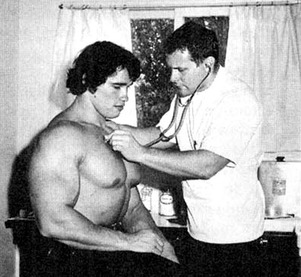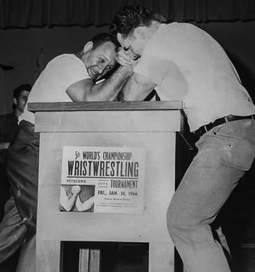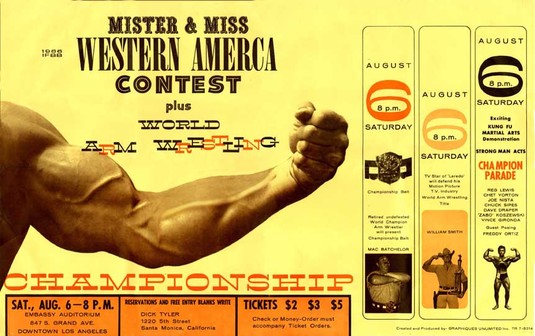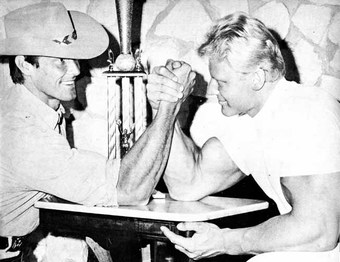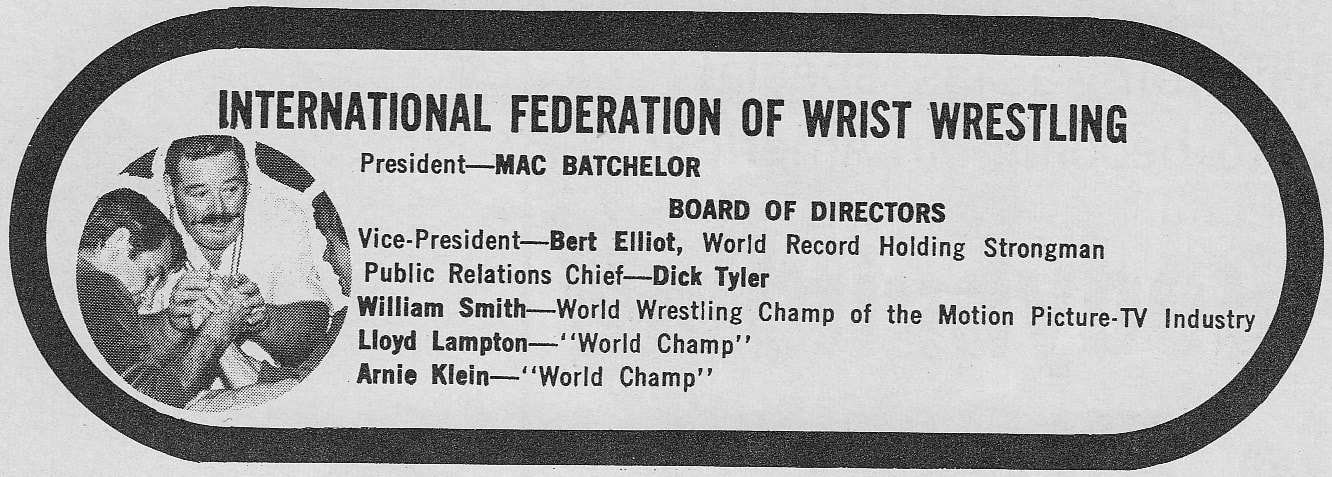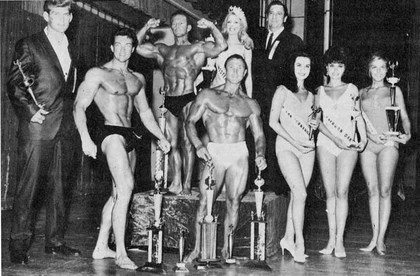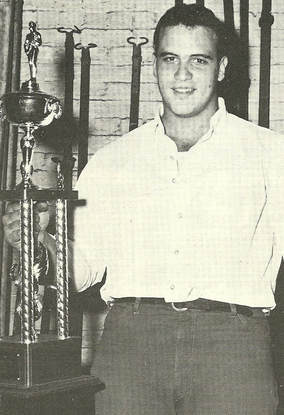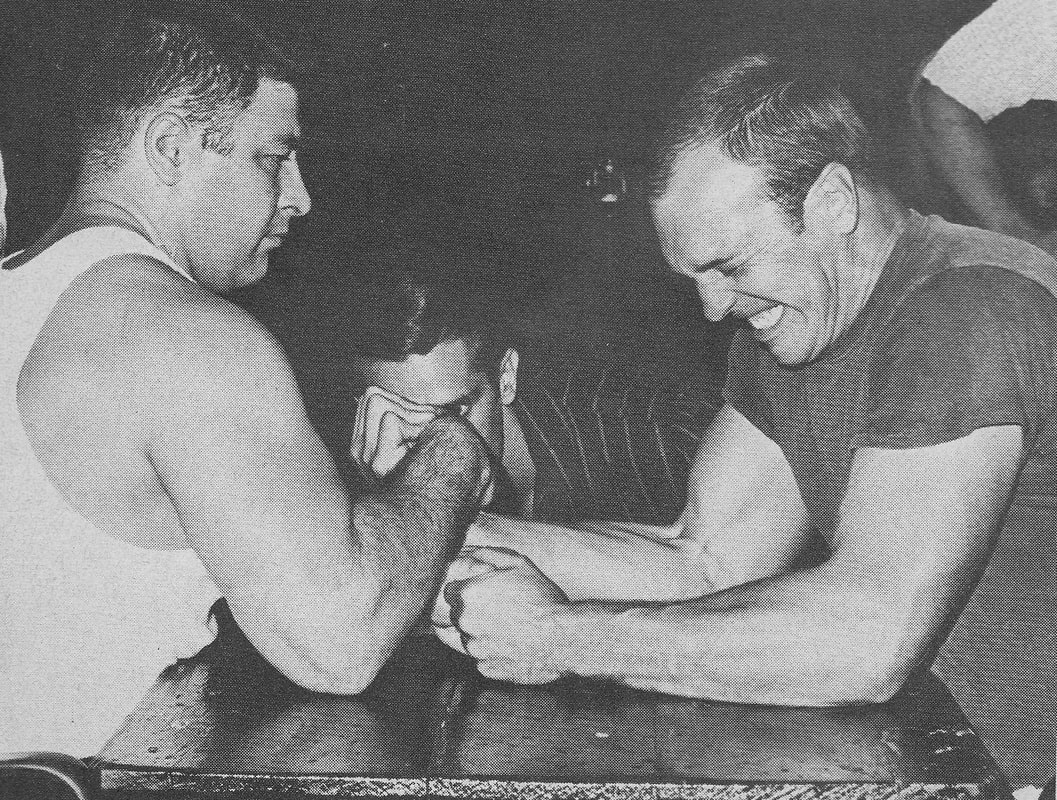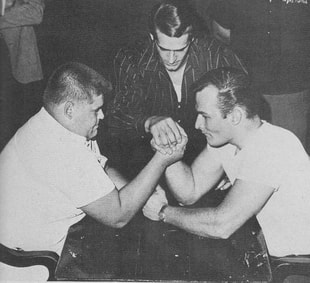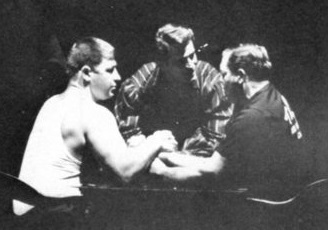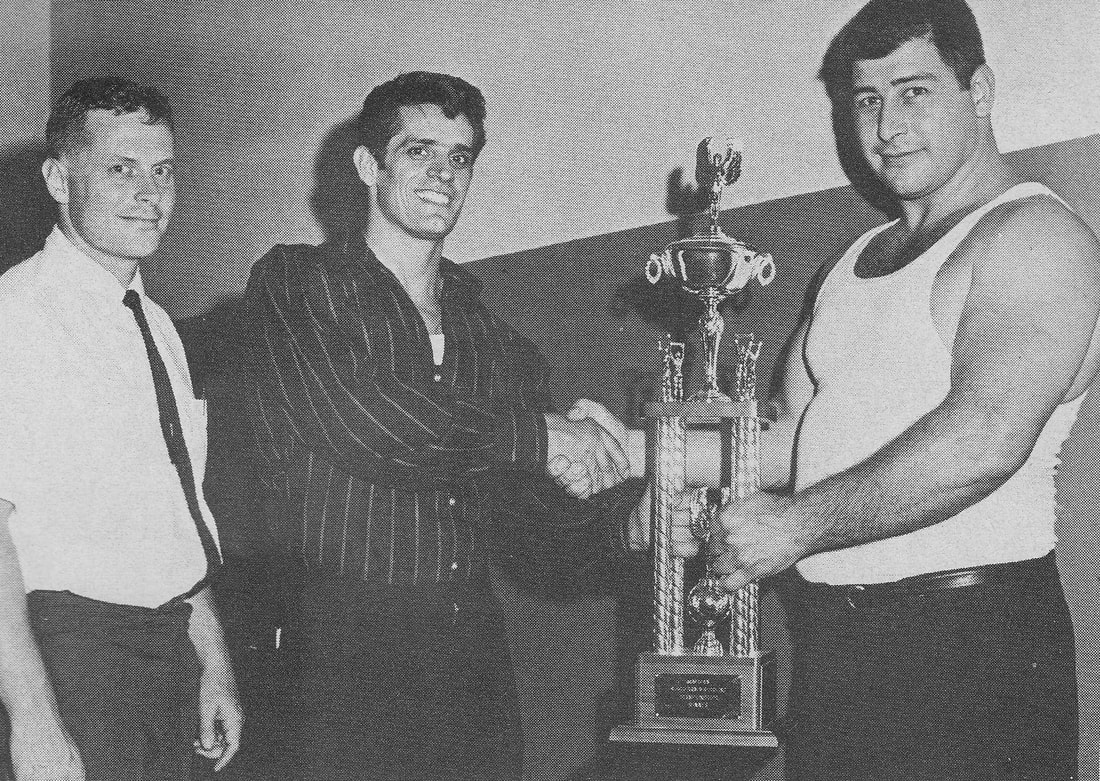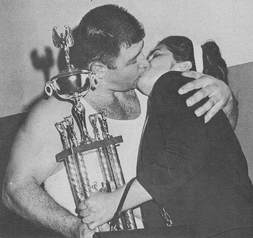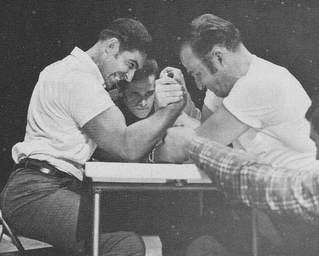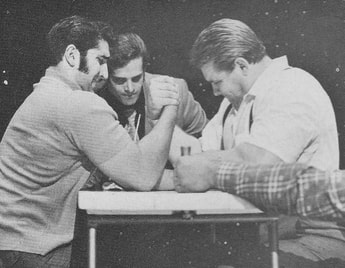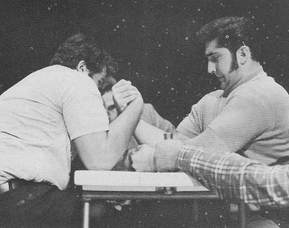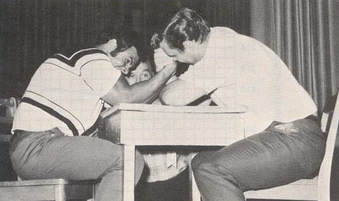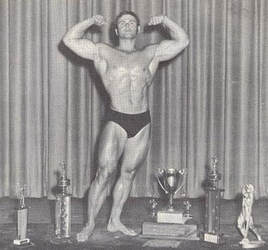International Federation of Arm Wrestlers (IFAW)
In 1966, Dick Tyler was a part-time muscle magazine reporter and student enrolled in chiropractic college in California. He was also involved in the organization of bodybuilding events for Joe Weider of the International Federation of Body Builders (IFBB). Joe was constantly trying to increase the draw and exposure of his shows and regularly featured non-bodybuilding segments. Dick, having always had an interest in strength disciplines, thought armwrestling would be a good addition, and Joe agreed.
Although Dick had never actually seen an armwrestling tournament, he did know a couple of men who were well-versed in the sport: Mac Batchelor and Bert Elliot. Mac was regarded by many as the best armwrestler of all time, having gone undefeated in 25 years of matches before retiring as the wrist wrestling champion of the world in 1956. Bert was a California bodybuilder, weightlifter, and strongman. He had also competed in the World’s Wristwrestling Championship in Petaluma in 1965 and 1966, and was familiar with how organized tournaments were run. Both Mac and Bert were thrilled will Dick’s idea of staging armwrestling contests and agreed to work with him to promote them any way they could
One of the first projects on which they embarked was to try to arrange a rematch between Chuck Ahrens and Arnie Klein. Chuck was a big man of almost mythical strength. Though he never actually competed in an official contest, he was known for his incredible demonstrations of strength on Muscle Beach and reportedly lifted incredible amounts of weight in the gym. In the late ‘50s and early ‘60s, many muscle magazines compared him with Paul Anderson – the proven king of weightlifting. Arnie was a former gymnast also from southern California. The story goes that some time in the late ‘50s 190-lb Arnie challenged Chuck to an impromptu match. Though only in his early 20s, Chuck already weighed nearly 300 lbs. He didn’t hesitate to accept the challenge as he was much bigger than Arnie and had never before lost in armwrestling. When the match got underway, Chuck surged but Arnie was able to hold off from being pinned by the big man. Rather than finish the match, Chuck stopped pulling. Many of those who witnessed this event felt that there was a good change that Chuck would have lost had the match kept going. In the years that followed, Chuck went on to perform more amazing feats, while Arnie went to Petaluma for the World’s Wristwresting Championship in 1965 and won the overall title in his first attempt.
Bert and Dick had the idea for the rematch – the next step was to contact Chuck and Arnie to see if they were interested. Mr. Ahrens, who now weighed close to 320 lbs, was up for it and even said that he had always wanted a rematch. But he had one request: he wanted to pull with the right as well as the left. He was left-handed and thought this would only be fair. Next, Arnie was called and he said that his right arm was out of commission – too much armwrestling had taken its toll and he probably needed an operation to fix it. Though he wasn’t left-handed, he said his left arm was fine and was willing to pull Chuck with it. With both men formally accepting the challenge, IFBB’s first armwrestling show was beginning to take shape.
Another idea that Dick had to bring attention to the sport was to include a division just for people who worked in the motion picture and television industry. Luckily, Dick knew someone who would be perfect as the face of this division: bodybuilder and television and film star Bill Smith. Bill was currently starring in Laredo, a western airing weekly on NBC. Dick used to train with Bill and he knew he was good at armwrestling. In fact, he was quite strong – he once did a reverse curl of 163 lbs at a body weight of 171 lbs! Dick contacted Bill to see if he was interested in being billed as the world champion of the film and TV industry and to take on all comers at the inaugural armwrestling event. Sure enough, he was.
With the anticipated rematch between Ahrens and Klein, as well as Bill Smith on board to add star power, all that was missing was an open armwrestling tournament. What better tournament to hold then a world championship? This is exactly what the IFBB decided to do – they called the event the IFBB World Arm Armwrestling Championship. Together, Bill Elliot, Mac Batchelor, and Dick Tyler believed they had all of the necessary elements to get armwrestling off on the right foot. The date for the first contest was set – it would be held on August 6th, 1966 at the Embassy Auditorium in Los Angeles, in conjunction with the Mr. Western America bodybuilding contest.
The World Championship consisted of a single elimination, right-handed, seated tournament with an open weight class. There were two divisions: one for members of the film and television industry, and one for everyone else. Mac Batchelor provided his sit-down armwrestling table for the event (believed to be the same table on which he won his world championship title in 1946 -- which also took place at the Embassy Auditorium!). Non-competing hands were not clenched – it appears competitors were free to grab the side of the table for leverage. Bert Elliot and Mac Batchelor officiated the tournament.
Kicking off the armwrestling segment was the left-handed match between Chuck Ahrens and Arnie Klein. The table was set up and the emcee proceeded to give some background on the match. When the two competitors were called to the table, Arnie Klein quickly came out and sat down. But where was Chuck? His name was called out on the microphone a couple of times, but there was only silence. Mr. Ahrens had not shown up! Arnie Klein was awarded the match by default and he was given a trophy and the title of Left-Hand World Champion.
Next up was the film and television industry division. There wasn’t an abundance of competitors, but several media outlets turned out to cover the action. Winners of preliminary matches earned the chance to face Bill Smith to try to take his crown. He defeated the first few challengers without too much effort. It seemed like he would have an easy day, until a young man came out of the crowd. The young man in question was Johnny Haemmerle, the lead singer of the group that was hired to play music throughout the days’ festivities. Johnny wasn’t a huge individual, and Bill figured it would be an easy final match for him. He was mistaken! Johnny proved to be a formidable adversary – he actually got the jump on Bill and looked headed towards a victory but an issue with the table required that the match be restarted. This time Bill took his opponent very seriously. He hit hard and brought Johnny’s arm about halfway down before it stopped. There was no movement for a short while before Bill finally mustered up enough force to bring Johnny’s arm down to the table top. Bill successfully defended his title of champion of the motion picture and television industry!
Finally, it was time for the open division to determine who would be the Right-Hand World Champion. The championship was intended to be an annual event, and therefore Dick Tyler thought a special championship belt would be a great award. It would be held by the current champion and subsequently be handed to the new champion whenever one was crowned. A beautiful belt was commissioned: it had a large plate engraved with two arms locked in combat, and on each side of the plate were two smaller blank plates, joined by chains, to be engraved with future winner's names.
Only a handful of competitors took part in the inaugural world championship. Because it was an open weight class, matches sometimes saw competitors of vastly different size face off against each other. It the end, the contest was won by the tallest competitor: 6'8" Lloyd Lampton from Los Angeles. His technique involved slamming his shoulder into his wrist and forcing his competitors down in one swift and effective move. At the conclusion of the tournament, the belt was presented to Lloyd by Mac Batchelor -- sort of a passing of the guard: the former world champion handing over the title to the new champion.
Soon after the Championship, it was decided that a proper organization should be formed – one that would act as a sanctioning body for armwrestling tournaments. The name International Federation of Wrist Wrestling (IFWW) was chosen. “Wrist Wrestling” was likely chosen over “Arm Wrestling” because the term had been gaining in popularity.
The IFWW now had established champions and strong leadership. At this point the organization was well-positioned for Joe Weider to promote it in his various muscle magazines (Mr. America, Muscle Builder/Power, etc.), which he proceeded to do over the following year.
After a full year without a sanctioned contest, another IFWW event was finally held in conjunction with the 1967 Mr. Western America contest on August 5th. This time, the event was simply billed as the Wrist Wrestling Championships, and the winner would receive an all-expenses-paid trip to the World Championship event being held the following month. Once again, several competitors returned, and for the second time in a row Lloyd Lampton emerged the winner. He already had the world title belt; this time he won a large trophy.
1967 saw IFWW’s first contest on the east coast. The World Arm Wrestling Championship moved to the biggest stage in professional bodybuilding: the IFBB Mr. Olympia contest at the Brooklyn Academy of Music in New York City. The event took place on September 23rd. Mac Batchelor’s armwrestling table was not shipped cross-country – a kitchen-style table was used along with two loose chairs. The table didn't have pads, but instead had two square areas delineated with tape that showed competitors where to place their elbows. Competitors used a wristwrestling set-up (with non-competing hands clenched). The official rules for the competition were as follows:
1. Right hand arm wrestling only.
2. Grip is thumbs only – not hands (palms are locked at the thumbs).
3. The free left hand is crossed in front and joins the left hand of opponent.
4. The referee gives only two signals – “Ready?” “Go!”
5. If the elbow lifts off the table it constitutes a foul. Two such fouls in one match gives the pin to the opponent of the offender.
6. A legitimate pin is scored when either contestant’s hand is pinned to the forearm of his opponent.
7. One pin constitutes a match.
Though he had earned his ticket to travel to New York, Mr. Lampton did not make the trip and so a new world champion would be crowned. Luckily, the contest had been promoted in Weider’s publications. This is how Virginia’s Steve Stanaway, who became a star of the sport over the next dozen years, first heard of organized armwrestling tournaments.
11 men competed in the 1967 World Championship, but because only 10 minutes of stage time was allotted to the armwrestling, the elimination rounds had to be done off stage in the afternoon. The final four competitors made it to the stage rounds. These men included 16-year old Nathan Schwarz (5’10”), 20-year old Marc Korman (6’2”), and 24-year old Alanis Delon (6’4”) – all three of whom weighed 240 lbs. Bill Strickland was the oldest competitor to make the final four and the smallest of the bunch (27 years, 6’ tall, and 195 lbs).
The first semi-final match saw Nathan pull Marc, with Marc earning the victory. The second match saw Alanis and Bill face off. To the audience, it seemed like a mismatch: Alanis had 20” arms, while Bill’s were only 14”. But the spectators soon found out that this is one of the things that makes armwrestling interesting – you can’t tell how good someone is going to be just by looking at them. Their match was very close, but Bill emerged as the winner! Then Bill had to face Marc in the final. This time, the bigger man had too much for the smaller man, and Mr. Korman became the new IFWW World Champion.
Some time in late 1967 or early 1968, the IFWW was renamed the International Federation of Arm Wrestlers (IFAW). The reason for the change is unclear, but it was perhaps to differentiate the sanctioning body from the Petaluma organization. Also, since the World Championship was called an “Arm Wrestling” event, it probably helped minimize confusion.
The 1968 IFAW World Arm Wrestling Championship was held on September 21st, once again in New York City as part of the Mr. Olympia festivities. There was a noticeable increase in competitors – approximately 30 in all – and it was a first official contest for many men who would go on to be among the very best arm wrestlers of the ‘70s: Connecticut’s Maurice “Moe” Baker, Virginia’s Ken Meade, and Massachusetts’ Al Turner. However, there was one person who was noticeably absent: Marc Korman. The rumour was that he had lost a match earlier in the year and decided to sit out the 1968 contest. Who would be the new champion?
Bert Elliot was not available to attend the 1968 contest, so Johnny Haemmerle (who, since his first taste of the sport in the 1966 contest had become a huge supporter) took on officiating duties. Since the tournament (as usual), used a single elimination format and just one open weight class, competitors drew numbers to determine match order. Each competitor would pull the competitor with the next consecutive number. After the first round, each winner was paired with the next winner in line, and so on, until only four men remained. These men would compete on stage before the audience in the evening. Those who eventually survived the elimination rounds were New York’s Bill Strickland (for the second year in a row), Steve Stanaway, Maurice Baker, and John Torch (a member of the Dukes of Dayton armwrestling team out of Ohio).
First up were 195-lb Steve Stanaway and 225-lb John Torch. There was a momentary struggle, but then John was able to drag Steve’s arm down. Next up were 200-lb Bill and 245-lb Moe. Moe won with a flash pin. It was then time for the final match of the evening – the match that would crown a new world champion. It took a while to set up the competitors, with each complaining that the other was trying to get and advantage before the go. Eventually, the referee was satisfied and gave the start command. Within a fraction of a second, John’s arm came down. In his first official armwrestling contest, Moe showed that he had what it took to be a world champion!
For the third year in a row, the IFAW World Arm Wrestling Championships were held on September 13th in New York City in conjunction with the 1969 Mr. Olympia (Arnold Schwarzenegger’s first Mr. Olympia contest). To increase competitor interest, the contest was expanded to offer two weight classes: up to 200 lbs, and over 200 lbs. Lighter pullers now had a better chance to shine.
The 1969 contest was also special because of another first: a pegged table. The new table was designed and constructed by Johnny Haemmerle, IFAW’s head referee. He took it upon himself to create a pegged table to reduce what he perceived to be a bigger possibility of cheating when non-competing hands were clenched in wristwrestling. However, judging from pictures of the event, it does not seem as though the pegs were used as intended. The competitors still competing using a wristwrestling set up, and the referees held onto the pegs!
When the final rounds of the armwrestling tournament were about to get underway, there was some concern among the organizers that there would be little crowd interest. The final scores for the Mr. Olympia contest were being tabulated and everyone was eager to find out who won between Sergio Oliva and Arnold Schwarzenegger. However, this concern soon dissipated, as the crowd really got into the armwrestling matches.
The 200-lb and under class was eventually won by Bill Strickland, who had competed in the contest the two previous years. While he figured well in 1967 and 1968, he was eventually bested by bigger, stronger competitors. But this time he proved to be the cream of the crop among men 200 lbs or less. He defeated Connecticut’s Joe Saucier.
As the reigning World Champion, Moe Baker was granted a bye to the finals. The rest of the field had to battle through the elimination rounds until four men remained, the best of whom would face Moe for the world crown. Those making it to the main stage were Boston’s Frank Martorana, Dennis Dase of Cincinnati, Brooklyn’s Nathan Schwarz, and Mike Whitaker from Virginia. Frank and Dennis were up first, with Frank getting the win on the much heavier opponent. Nathan then pinned Mike. He then proceeded to completely overpower Frank. Nathan Schwartz was going to face Maurice Baker in the finals.
Nathan had an interesting back story. He had attended the IFWW World Championship in 1967 and did very well reaching the semi-finals. He returned for the 1968 event, only to find out that he had missed the elimination rounds that had taken place earlier in the day. He was furious, because he felt he could beat all of the other competitors. He even taunted the other men ("you all chicken?"). Those still in the tournament were not allowed to pull him, but a few of the eliminated competitors stepped up and agreed to face him in unofficial matches. He easily defeated all of them. He then looked at the finalists and said "I can beat anyone here." One year later, Nathan's comment was still on Moe's mind. He wanted to face Nathan more than anyone in the world: "I've been waiting a full year to beat that man. I don't want anyone to have him but me." When they finally met up, both men were extremely excited -- so much so that Moe got an elbow foul right after the start command was given. If he did it once more, he would lose the match. This would have been too much for him to take. On the restart, he made no mistakes and he slammed Nathan's arm down, showing everyone that HE was the best!
It is unclear if the IFAW sanctioned armwrestling tournaments other than the annual World Championship between 1968 and 1970. This would have been their intention, but it is not known if it actually happened. However, one other armwrestling tournament from the era seems like it very well could have been an IFAW tournament. It was the Canadian Arm Wrestling Championship, which was run in conjunction with the IFBB Mr. Canada bodybuilding contest in Vancouver, British Columbia, on May 31st, 1970. Only four men took part in this tournament, including Vince Basile, the man who would go on to win the Mr. Canada title that year. Vince made it to the finals of the armwrestling tournament, but ultimately lost to Vancouver’s Jim Forsythe, who outweighed him by 40 lbs.
Few details about the 1970 World Championship have been found. Once again, the tournament took place in conjunction with the Mr. Olympia contest on October 3rd at the Town Hall in New York City. Full results for the event may be lost to time as it appears they were never published. However, what is known is that Maurice Baker successfully defended his title for the third year in a row, while Steve Stanaway earned his first world title by taking the 200-lb class.
In 1971, the Mr. Olympia bodybuilding contest was held in Paris, France. This resulted in plans to move the IFAW World Arm Wrestling Championships so that they would be held in conjunction with the IFBB Mr. America bodybuilding contest. The event was announced, but for unknown reasons the IFAW event didn't occur. No records have been found indicating that IFAW tournaments were held after 1970.
The IFAW was around for less than five years. Though its events were small in comparison to the World’s Wristwrestling Championship in Petaluma, the organization can be credited with growing the sport through regular promotion in the muscle magazines of the era. If it was not for this coverage, some of the earliest east coast stars of the sport may have never discovered tournament armwrestling.
Researched and Written by Eric Roussin
Original article published in 2011. Completed revised and updated in 2017.
Special thanks to Dick Tyler, Steve Stanaway, and Chris Haemmerle without whose help this page would not have been possible.
